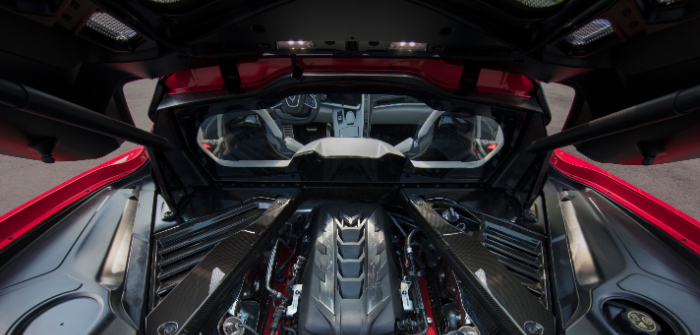Sitting at the heart of the 2020 Corvette Stingray is Chevrolet’s next-generation 6.2-liter small block V8 LT2 engine. The naturally aspirated unit will produce 500ps and 637Nm of torque when equipped with performance exhaust.
“Although now placed behind the driver, the LT2 gives the same visceral experience we all expect from Corvette,” said Jordan Lee, GM’s global chief engineer for small block engines. “The LT2 has been designed to deliver excellent low-end torque and high-end power to give thrilling pedal response at any RPM.”
The powertrain’s low position enables a low center of gravity for optimal handling. The eight cylinder’s biggest upgrade is found in the lubrication and ventilation system. For the first time, the base Stingray will use an engine-mounted dry sump oil system and three scavenge pumps for improved track performance.
During serious track driving, oil volume remains high to avoid diminished performance. The new Stingray’s lateral capability is greatly improved, so the LT2’s dry sump lubrication system had to be redesigned to provide exceptional engine performance even at lateral acceleration levels exceeding 1G in all directions.
With improved handling in mind, the team at Chevrolet also developed a brand-new block and vent system. This means the centerline of the crankshaft sits an inch lower to the ground where it mates to the transaxle.
The next generation LT2 is paired with Chevrolet’s first 8-speed dual-clutch transmission. Designed in collaboration with Tremec, the gearbox aims to provide the connected feeling of a manual along with the comfort of an automatic. A double-paddle de-clutch feature allows the driver to disconnect the clutch for more manual control.
“The performance shift algorithms are so driver-focused, they can sense when you’re doing spirited driving – regardless of driving mode – and will hold lower gears longer for more throttle response,” added Juechter.
Chevrolet’s small block V8 has a torque curve optimized to take advantage of the DCT. Engineers set the DCT to have a very low first gear to leverage additional traction, and its close-ratio gears two through six keep the engine near the power peak on track. Tall seventh and eighth gears are designed for long-distance cruising with low mechanical stress and improved fuel economy.




